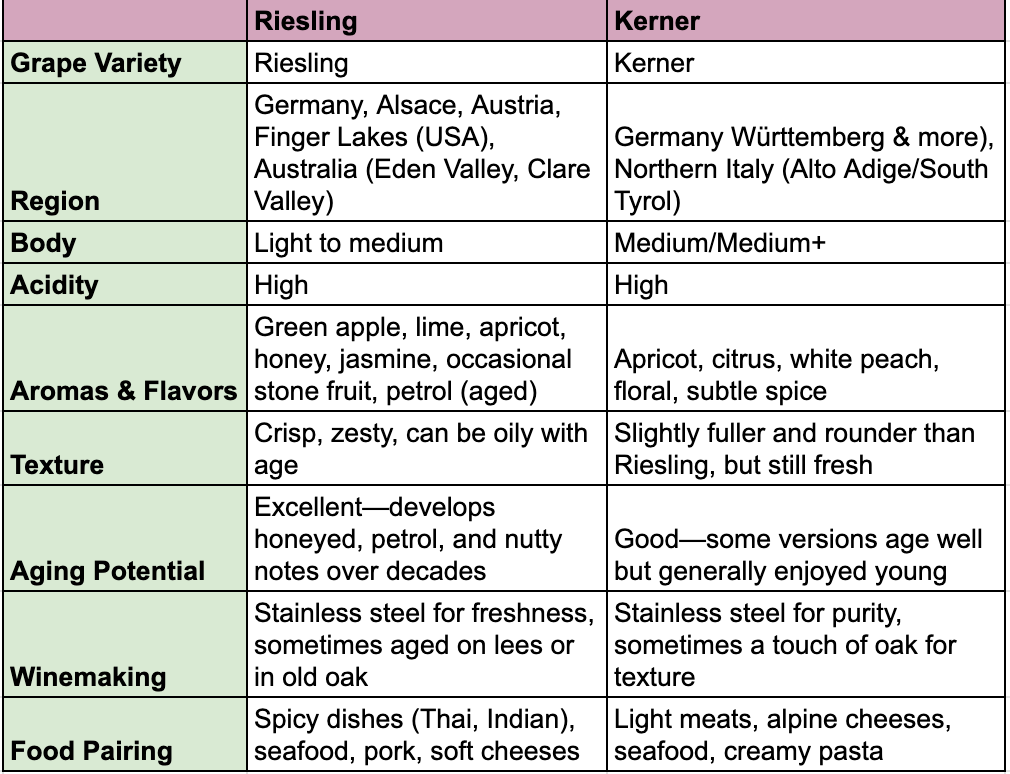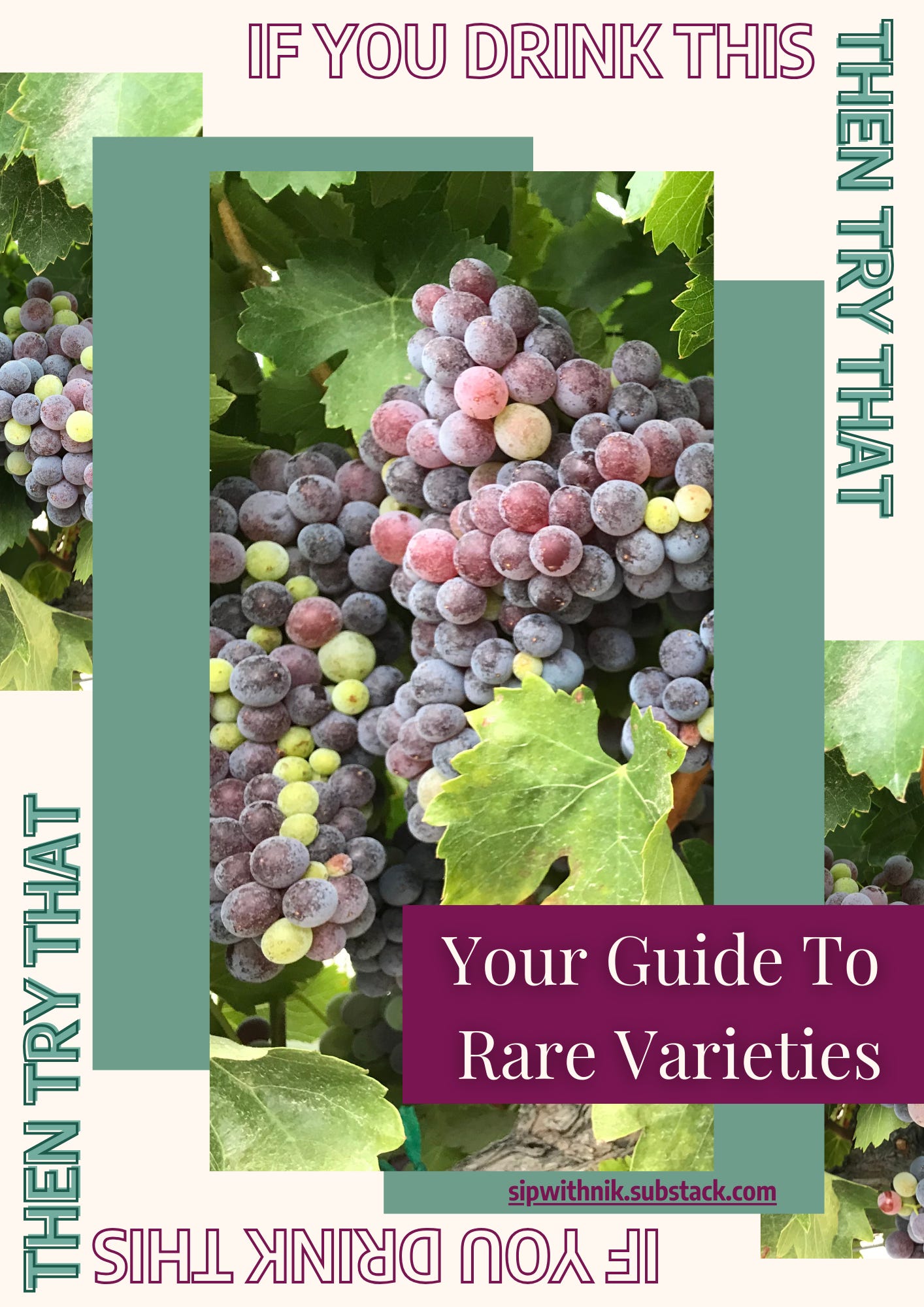Welcome to Drink This, Not That!—your guide to discovering wines beyond the usual suspects.
If you always reach for the same bottle, consider this your invitation to mix it up. Each week, I’ll introduce you to a lesser-known but equally (if not more) delicious alternative to a wine you already love. It’s an easy way to expand your palate, support winemakers who are keeping tradition alive, and bring something unexpected to your next gathering.
Because if we celebrate diversity in life, shouldn’t we do the same in our wine glass?
Here’s what we’ve covered so far:
Disclaimer: I absolutely love Riesling. It’s actually one of my favorite varieties. I am in no way trying to dissuade you from drinking Riesling. I’m just aiming to help you branch out in your wine selection and expand your knowledge with this series. 😉
What is Kerner?
Kerner is a white grape variety developed in 1929 in Württemberg, Germany. It was created by crossing Riesling and Trollinger (also known as Schiava Grossa or Vernatsch), making it an aromatic and fresh yet slightly fuller-bodied alternative to Riesling. According to Wine-Searcher, it’s named after Justinus Kerner, a 19th-century German poet and writer of drinking songs, this grape has gained popularity for its ability to thrive in various growing conditions.
Side note: what a legacy to leave behind – “writer of drinking songs.” Who do you think would have that title today? Let me know in the comments below.
Much like Riesling, Kerner is high in acidity, with an ability to age well. However, it tends to have a slightly rounder texture, making it a great option for those who love the vibrancy of Riesling but want something a little different.
Riesling vs. Kerner Key Differences
Where is Kerner Grown?
While Germany remains the primary producer of Kerner, it is also cultivated in Italy’s Alto Adige/Südtirol, Austria, Switzerland, England, Canada, and Japan. In Germany, it is widely planted in the Pfalz and Rheinhessen regions, known for their expressive white wines.
In the Vineyard: What Makes Kerner Unique?
Kerner isn’t all that picky about where it’s grown, making it appealing to growers. Since Riesling in Germany is quite site specific, this creates a great opportunity for Kerner to fill in the gaps, so to speak. It’s a late-budding variety, thus generally protected from spring frosts, is high-yielding and ripens reliably. Sounds like a grower’s best friend, especially in these cool climate regions.
Why Try Kerner?
Aromatic and fresh: If you love the citrus and stone fruit notes of Riesling, Kerner offers a similar profile with a touch more roundness.
Food-friendly: Its acidity and fruit-forward nature make it versatile for pairing with seafood, creamy dishes, and even spicy cuisine.
Underrated but high-quality: Kerner is often overshadowed by Riesling but has proven to be one of the most successful German grape crossings.
Top Producers to Try
If you’re ready to explore Kerner, here are three producers to check out:
Abbazia di Novacella Kerner (Alto Adige, Italy) — Crisp, aromatic, and structured with notes of peach, citrus, and spice.
Imported by Skurnik if you’d like to track down a bottle.
I purchased mine through Flatiron Wine & Spirits San Francisco.
My tasting notes: beautifully aromatic, brimming with notes of white peach, juicy pear, lime zest, lime verbena, and a delicate white floral aroma. Rich, mouth filling palate with a voluptuous mouthfeel, high, mouthwatering acidity, and similar flavors, nicely concentrated.
This Kerner hails from the Alto Adige Valle Isarco DOC, which you can learn more about here and here.
Cantina Valle Isarco Kerner (Italy) — A refreshing and mineral-driven wine with vibrant acidity and elegance. Here’s a review from Wine Enthusiast.
I have yet to try a German Kerner, but Falstaff has this exceptional list of top Kerner wines from Germany that seems to be a great place to start!
Final Thoughts
Kerner is an exciting alternative to Riesling that offers a fresh take on the aromatic white wine experience. If you enjoy crisp, high-acid wines with bright fruit flavors, this is a must-try variety.
Ready to explore more underrated wines? Subscribe to Sip with Nik for exclusive wine recommendations and get my guide If You Drink This, Try That to discover your next favorite bottle!













